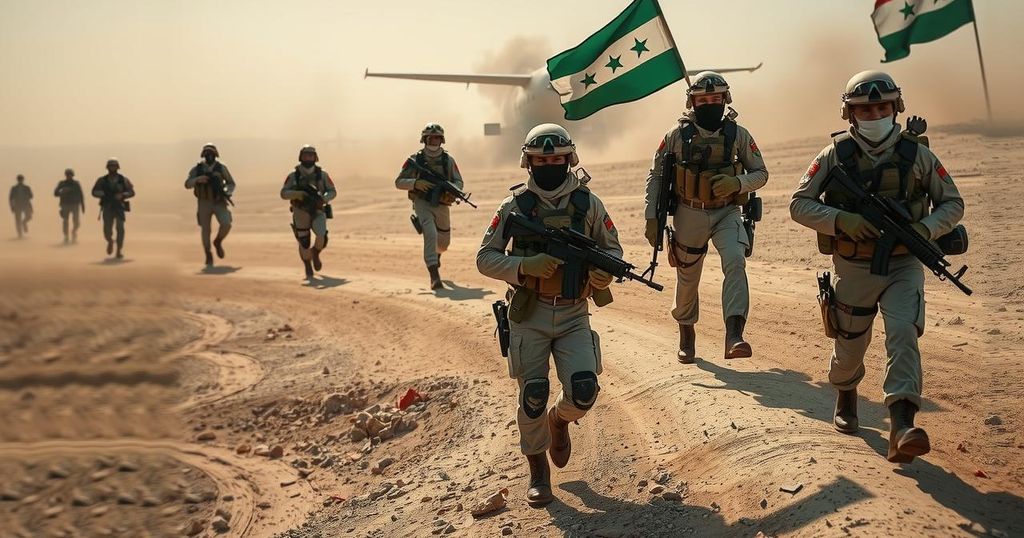Iran has largely withdrawn its military forces from Syria after rebels defeated the Assad regime, signaling a significant blow to Tehran’s influence in the region. The alignment with Assad has weakened, and Iranian troops have fled amid rapid rebel advancements. Consequently, Iran’s future presence in Syria appears jeopardized as the new Sunni leadership shows strong opposition, and the potential for unrest threatens Iranian interests.
Iran is reportedly withdrawing nearly all its forces from Syria following the success of rebel groups in their offensive against President Bashar al-Assad’s regime. This significant development has been characterized as a serious setback for Tehran’s influence in the region. Western and Arab officials have reported that Iranian troops, who maintained a presence in Syria as part of an alliance with the Assad regime, have either retreated or have been ordered to leave the country.
Images displaying abandoned military assets near the Lebanese border indicate that many Iranian forces fled rapidly as the rebels performed a stunning takeover in just eleven days. Barbara Leaf, the U.S. State Department’s leading official for the Middle East, confirmed this assertion by stating, “Pretty much, yes.” Leaf further remarked on the unprecedented nature of this withdrawal.
Historically, Syria has served as Iran’s principal ally in the Middle East, helping to strengthen Tehran’s so-called “Axis of Resistance,” which included supporting militant groups in their attacks against U.S. and Israeli positions. The Iranian military presence was also crucial for sheltering bases for Hezbollah, which have since faced devastation from Israeli actions and rebel assaults.
With Assad’s regime dismantled and the Iranian-supported forces significantly diminished, Iran finds itself lacking a vital ally in the region. This transition has not gone unnoticed by Iranian officials, who are reportedly expressing concern over the implications of a burgeoning Sunni leadership that opposes both Iran and the Assad administration.
Ahmed al-Sharaa, a prominent rebel leader, stated that the rapid success against the Assad regime has effectively “set the Iranian project in the region back by 40 years.” The rebels’ longstanding animosity toward Iran leads officials to believe that the Islamic Revolutionary Guard Corps (IRGC) will struggle to reassert itself in Syria or reestablish connections with Hezbollah, which has had its capabilities severely compromised by Israeli actions.
In response to the shifting power dynamics, hardliners in Tehran have begun calling for a strategic counter-response, indicating a deep-seated reluctance to relinquish influence in the face of unfavorable developments. The IRGC’s affiliated media has labeled Syria’s new governance structure as “takfiri terrorists,” a pejorative term historically reserved for ISIS affiliates, suggesting that Tehran perceives possible uprisings in the region as imminent. This vulnerability in Iranian influence comes shortly before President-elect Donald Trump assumes office, with indications that he may consider military interventions to curtail Iran’s nuclear endeavors.
The article sheds light on the evolving geopolitical landscape in the Middle East, specifically focusing on Iran’s military presence in Syria and its subsequent withdrawal. Iran’s forces had aligned with the Assad regime in Syria for years, supporting militant actions and exerting influence. However, the swift victory of rebel factions over Assad has drastically altered this dynamic, leading to the near-complete removal of Iranian troops. This shift underscores the challenges faced by Tehran amidst changing alliances and opposition from new Sunni leadership. The background also highlights the historical context of Iran’s involvement in Syria and its implications for regional stability, terrorism, and Iran’s broader geopolitical strategies.
In summary, Iran’s near-total withdrawal from Syria represents a significant shift in the balance of power in the Middle East. The fall of Assad has not only weakened Iranian influence but has also invigorated rebel factions that oppose Iran’s agenda. The potential resurgence of Iranian forces faces considerable hurdles, given the rebels’ leadership and their expressed intent to counter Tehran’s involvement. This unfolding situation will warrant keen observation, especially with an incoming U.S. administration potentially adopting a more aggressive stance towards Iran’s regional activities.
Original Source: nypost.com






